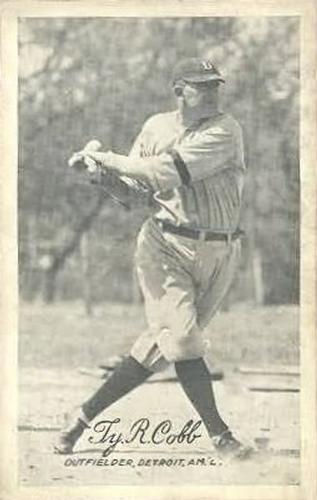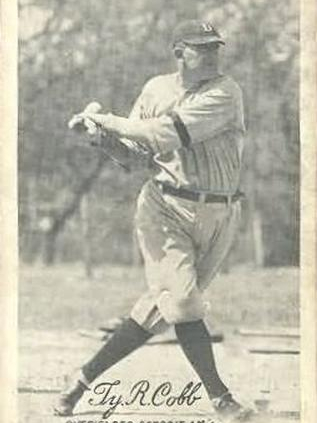May 5, 1925: Ty Cobb hits 3 home runs, sets total bases record as Tigers pummel Browns, 14-8
 The Detroit Tigers, led by player-manager Ty Cobb, got off to a slow start in the 1925 season. Going into St. Louis in early May for a four-game series against the Browns, the Tigers had a 4-13 record with one tie. The team was stuck in the American League cellar and had yet to win back-to-back games in the young season.1
The Detroit Tigers, led by player-manager Ty Cobb, got off to a slow start in the 1925 season. Going into St. Louis in early May for a four-game series against the Browns, the Tigers had a 4-13 record with one tie. The team was stuck in the American League cellar and had yet to win back-to-back games in the young season.1
One issue for the Tigers was that the 38-year-old Cobb – in his 21st season as a player and fifth season since adding managerial duties in 1921 – did not play in the first 12 games of the season due to influenza and sore legs. Cobb’s first start came on April 27, when the Browns visited Detroit. Cobb went 1-for-3 in the contest.
Tiger troubles continued in the first game of the set at Sportsman’s Park in St. Louis. On May 4 the Browns earned a 5-4 victory behind the pitching of Dixie Davis and three hits and three RBIs from St. Louis player-manager George Sisler. Cobb had two singles in three at-bats in the loss, which dropped Detroit 8½ games behind the league-leading Cleveland Indians, Washington Senators, and Philadelphia Athletics, all tied atop the AL at 11-4.2
Temperatures in the low 60s3 greeted the two clubs for the May 5 contest. Cloudy and cool was the forecast for the early-season contest.
Detroit got things going quickly, roughing up Browns pitchers for eight runs in the first two innings. First baseman Lu Blue tripled off veteran right-hander Bullet Joe Bush to open the game. Second baseman Frank O’Rourke doubled Blue home. Cobb, playing center field, then connected for his first home run of the season to give the Tigers a 3-0 lead. Bush never quite recovered, though the Browns made a valiant effort at a comeback.
The fireworks were just getting started as St. Louis got to Tigers lefty Dutch Leonard, scoring four runs in the bottom of the first inning. The biggest blow was a three-run homer from Baby Doll Jacobson.
But the day belonged to Cobb and the Tigers. With two out in the second inning, Blue and O’Rourke tied the game with back-to-back doubles. After Sisler replaced Bush with Elam Vangilder, Cobb connected for his second home run of the game. Detroit was ahead, 6-4. The Tigers made it a five-run inning when right fielder Harry Heilmann singled and left fielder Heinie Manush hit a two-run homer.
Detroit got another run in the third on a walk, a single, and a groundout. Then Cobb led off the fourth inning with a double and was sacrificed to third by Heilmann. He then scored on a sacrifice fly and the Tigers had built a 10-4 lead.
It was now St. Louis’s turn to rally. The Browns nearly came all the way back with four runs in the bottom of the fifth inning. Leonard managed to get only one out in the frame before being relieved by Ken Holloway. Holloway threw a run-scoring wild pitch, walked pinch-hitter Harry Rice, and was replaced by lefty Ed Wells, who got the Tigers out of the inning with a 10-8 lead.
Cobb stayed hot with a sixth-inning single in the midst of a run-scoring rally led by Heilmann’s double. In the eighth inning, Detroit built on its 11-8 lead as Cobb started the inning with his third home run of the game. The 13th run for the Tigers came in as third baseman Bob Jones doubled home Manush.
Not quite finished, Detroit added a final run in the ninth when Cobb singled with Blue on second base. The official scorer ruled that an error by Browns second baseman Marty McManus had caused the run to score and did not credit Cobb with an RBI. Wells preserved the lead with 4⅔ innings of scoreless pitching.4
When the dust settled, Cobb had established a post-1900 American/National League record with 16 total bases in one game, and the Tigers had a much-needed 14-8 victory. It was “one of the great hitting sprees in Cobb’s career and indeed in baseball history,” biographer Charles Alexander wrote.5 Cobb went 6-for-6 with three home runs, a double, two singles, four runs scored, and five runs driven in.
The “regal Bengal of the Tiger lair” is how The Sporting News referred to Cobb after his outburst.6 His 16 total bases surpassed the previous record of 13 set by former Washington Senators’ catcher Patsy Gharrity in June 1919.
Additionally, Cobb’s three home runs in one game tied the post-1900 record at that time shared by Ken Williams of the Browns (1922); Butch Henline (1922) and Cy Williams (1923), both of the Philadelphia Phillies; George Kelly of the New York Giants (1923 and 1924); and Joe Hauser of the Philadelphia Athletics (1924).7
According to one account of the game at Sportsman’s Park, such “an orgy of base hits … was startling even in these days of the rabbit ball.”8 In an era that was still adjusting from the dead ball to the lively ball, this observation of an “orgy” was quite accurate. The six instances of three-homer games all occurred in the three seasons preceding Cobb’s feat. Over the next six weeks, Mickey Cochrane of the A’s and Goose Goslin of the Senators joined the three-homer club.9
The 1925 season was a point in Cobb’s career when he might have been expected to slow down. In fact, Cobb was aware of his seemingly diminished eyesight and had put off needed surgery for years.10
Despite these concerns, the Georgia Peach was off to a fine but limited start in 1925. “[H]e ripped everything – beating out bunts, driving screamers down the baselines, handling breaking pitches as well as ever.11 Going into St. Louis, Cobb was 9-for-23 (.391) – a number that was boosted to .531 after his productive day. But close observers might have had a hint of Cobb’s heroics to come.
By some accounts, Cobb may have called his shot going into the May 5 game. Biographer Al Stump asserted that Cobb directly told two sportswriters that “[f]or the first time in my life, I will be deliberately going for home runs.”12
While aspects of Stump’s biography have been questioned over the years, others have corroborated the notion that Cobb predicted his long-ball heroics.13 Hall of Fame umpire Billy Evans was behind the plate on May 5 and supported Cobb’s subsequent assertion that he had adjusted his grip and swing in an attempt to hit the ball farther. Evans also pointed out that “a strong wind was blowing the ball in the direction of the short right field bleachers at St. Louis.”14
If Cobb called his shot, it was likely no accident that it happened in St. Louis, where the right field bleachers were only 310 feet from home plate, and where Cobb hit home runs with more frequency over his career than at any other park – including Navin Field in Detroit.15
Regardless, what followed on May 5 (and May 6, when he slugged two more homers and had six RBIs) showed that Cobb, even near the end of his career, was capable of backing up his words with deeds.
Acknowledgments
This article was fact-checked by Mike Huber and copy-edited by Len Levin.
Photo credit: Ty Cobb, Trading Card Database.
Sources
In addition to the sources cited in the Notes, the author consulted Baseball-Reference.com and Retrosheet.org.
https://www.baseball-reference.com/boxes/SLA/SLA192505050.shtml
https://www.retrosheet.org/boxesetc/1925/B05050SLA1925.htm
Notes
1 Harry Bullion, “Modern Record Set as Tigers Triumph,” Detroit Free Press, May 7, 1925: 18.
2 St. Louis Post Dispatch, May 5, 1925: 22.
3 St. Louis Star & Times, May 5, 1925: 1.
4 In accordance with baseball’s scoring rules of 1925, Leonard was credited with the win despite pitching only 4⅓ innings. Modern references like Baseball-Reference.com and Retrosheet.org have retroactively awarded Wells a save. Frank Vaccaro, “Origin of the Modern Pitching Win,” SABR Baseball Research Journal, Vol. 42, No. 1 (2013).
5 Charles C. Alexander, Ty Cobb (New York: Oxford University Press, Inc., 1984): 175.
6 “Manager Ty Cobb,” The Sporting News, May 14, 1925: 1.
7 Harry Bullion, “Bengal Pilot Leads Rout With Six Hits,” Detroit Free Press, May 6, 1925: 16. Joseph Reichler and Ken Samelson, The Great All-Time Baseball Record Book (New York: Macmillan Publishing Co., 1993); 70, 73.
8 Bullion, May 6, 1925: 16.
9 Reichler and Samelson, 70, 73.
10 Al Stump, Cobb A Biography (Chapel Hill, North Carolina: Algonquin Books of Chapel Hill, 1994), 360. According to Stump, Cobb had delayed eye surgery needed since 1923. Prior to the 1926 season, Cobb finally underwent surgery for removal of pterygium, a cloudy substance that impaired his vision.
11 Stump, 361.
12 Stump, 362.
13 “Did Ty Cobb Call His Shot in St. Louis in 25[?] New Information Strongly Suggests That He Did Indeed,” BigLeagueInvestigations.com, July 26, 2021, https://www.bigleagueinvestigations.com/post/did-ty-cobb-call-his-shot-in-st-louis-in-25-new-information-strongly-suggests-that-he-did-indeed.
14 “Billy Evans Says,” Lexington (Kentucky) Herald-Leader, May 14, 1925: 5.
15 Cobb connected for 20 of his 117 career home runs at Sportsman’s Park, while hitting 32 at home while a member of the Tigers. According to Retrosheet.org, he hit one homer in every 36 at-bats in St. Louis but only one in every 159 at-bats in Detroit. Cobb did hit home runs more frequently at Yankee Stadium, but the sample size is relatively small, seven homers in 189 at-bats. The Browns also enjoyed hitting at home, collecting 73 homers at Sportsman’s Park while garnering only 37 on the road during the 1925 season.
Additional Stats
Detroit Tigers 14
St. Louis Browns 8
Sportsman’s Park
St. Louis, MO
Box Score + PBP:
Corrections? Additions?
If you can help us improve this game story, contact us.


